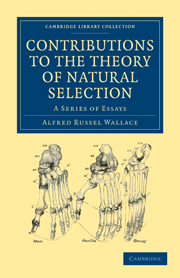Book contents
- Frontmatter
- Preface
- Preface to the Second Edition
- Contents
- I On the Law which has regulated the introduction of New Species
- II On the Tendency of Varieties to depart indefinitely from the Original Type
- III Mimicry, and other Protective Resemblances among Animals
- IV The Malayan Papilionidœ, or Swallow-tailed Butterflies, as illustrative of the Theory of Natural Selection
- V On Instinct in Man and Animals
- VI The Philosophy of Birds' Nests
- VII A Theory of Birds' Nests; showing the relation of certain differences of colour in female birds to their mode of nidification
- VIII Creation by Law
- IX The Development of Human Races under the Law of Natural Selection
- X The Limits of Natural Selection as applied to Man
- NOTES
- INDEX
III - Mimicry, and other Protective Resemblances among Animals
Published online by Cambridge University Press: 29 August 2010
- Frontmatter
- Preface
- Preface to the Second Edition
- Contents
- I On the Law which has regulated the introduction of New Species
- II On the Tendency of Varieties to depart indefinitely from the Original Type
- III Mimicry, and other Protective Resemblances among Animals
- IV The Malayan Papilionidœ, or Swallow-tailed Butterflies, as illustrative of the Theory of Natural Selection
- V On Instinct in Man and Animals
- VI The Philosophy of Birds' Nests
- VII A Theory of Birds' Nests; showing the relation of certain differences of colour in female birds to their mode of nidification
- VIII Creation by Law
- IX The Development of Human Races under the Law of Natural Selection
- X The Limits of Natural Selection as applied to Man
- NOTES
- INDEX
Summary
There is no more convincing proof of the truth of a comprehensive theory, than its power of absorbing and finding a place for new facts, and its capability of interpreting phænomena which had been previously looked upon as unaccountable anomalies. It is thus that the law of universal gravitation and the undulatory theory of light have become established and universally accepted by men of science. Fact after fact has been brought forward as being apparently inconsistent with them, and one after another these very facts have been shown to be the consequences of the laws they were at first supposed to disprove. A false theory will never stand this test. Advancing knowledge brings to light whole groups of facts which it cannot deal with, and its advocates steadily decrease in numbers, notwithstanding the ability and scientific skill with which it may have been supported. The great name of Edward Forbes did not prevent his theory of “Polarity in the distribution of Organic beings in Time” from dying a natural death; but the most striking illustration of the behaviour of a false theory is to be found in the “Circular and Quinarian System” of classification propounded by MacLeay, and developed by Swainson, with an amount of knowledge and ingenuity that have rarely been surpassed. This theory was eminently attractive, both from its symmetry and completeness, and from the interesting nature of the varied analogies and affinities which it brought to light and made use of.
- Type
- Chapter
- Information
- Contributions to the Theory of Natural SelectionA Series of Essays, pp. 45 - 129Publisher: Cambridge University PressPrint publication year: 2009First published in: 1870
- 1
- Cited by



